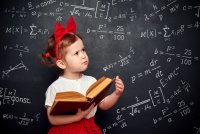Learning Math by Seeing It as a Story
An English teacher co-teaching trigonometry asked students to explain an equation to a child and to turn discrete problems into a story.
I had always hated math. Now I suddenly found myself teaching trigonometry. I was an English teacher in Chicago Public Schools with certification in special education, and when my school was facing a shortage of certified special education teachers, I was pulled in mid-year to co-teach a junior-level trigonometry class with the math teacher.
My students struggled with the calculations, thinking they just weren’t good at math. Like me, they hated it. What was the point in working and reworking these calculations? What were we trying to figure out anyway? And I originally agreed with them.
Yet trig slowly became my favorite class of the day. After spending years teaching English and reading, I was being challenged to move beyond what I had always been doing. When you’re new to something, you have a fresh perspective. You’re willing to take risks. You’re willing to try anything because you don’t know how something should be done.
I worked with my co-teacher to create a series of supplementary lessons through a different lens to let students experience personal meaning and creativity in their math.
Explaining It to a Baby
I found that many students felt frustrated with math because they needed to come to one single correct answer. This was especially hard with my diverse learners, who struggled with multistep equations. Instead of focusing on coming to the correct answer, my students and I focused on the process of getting there.
I brought in some books from Chris Ferrie’s Baby University series—books like General Relativity for Babies and Optical Physics for Babies. The idea is that you don’t fully know something unless you can break it down so simply that you can explain it to a young child.
That’s the task I gave my students. We started by reading Ferrie’s board books to see how simple language and illustrations could be used to explain complex subjects. Next, students chose a multistep equation they had initially struggled with. Working in pairs or small groups, they talked through their thinking and the steps needed to solve the equation. Their partners were encouraged to ask questions and get clarification so the ideas were explained at the simplest level.
Using the books as models, students revised and wrote down their explanations to make them so simple that they could be explained to a young child. After they wrote out their explanations, my co-teacher and I challenged them to create short books using card stock and colored pencils. Students worked with their small groups to talk through ideas and illustrate their books. If they struggled, they were able to pair with another student to create a book together.
Sharing with other students helped them explain ideas in new ways, which helped them develop a deeper understanding. Students were pushed to think metacognitively in order to explain their thinking and their process to others, and the class as a whole gained access to varying perspectives in math by hearing their peers’ thought processes. And they were all excited to see how they could use writing and art skills in an authentic way in math class.
Putting the ‘Story’ in ‘Story Problem’
The interesting thing often overlooked in math class is that it already includes stories and real-life connections, in the form of story problems. But the story problems are generally discrete—each is an individual unit, and they don’t tell a larger story.
Another issue is that the real-life elements usually don’t relate to things that are real issues in students’ lives. They might include calculating area so that someone can buy new carpet for their home. Or a story problem might be about landscapers planting a new tree, and needing to calculate the length of wire required to support the tree. These might be things the students will do later as adults, but they’re not current issues in the teens’ experience.
I used story problems as an opportunity to connect math to students’ lives by creating fictional math-based stories. First, students would work in small groups to go through the chapter in their math textbook and collect the story problems, writing them on index cards. Next, students would lay out the cards to see the questions as a whole: Out of 10 or more story problems in the chapter, were there five similar ones they could group together? What problem-solving skills were called for to work on these problems?
Looking at these five unconnected stories, students thought why they needed to solve them, and used their reasons to come up with some type of connected ideas. They created backstories for the names in the problems, in the process turning them into more developed characters. They identified challenges or reasons why the characters needed to solve the problem.
Finally, they combined the story problems they had created and developed a longer narrative to connect these scenarios, an overarching story rooted in authentic math story problems. Survival was a common theme: One group wrote about a zombie apocalypse and another imagined an alien invasion, situations in which characters needed to solve the problems and employ skills that would help them survive. It’s true that these stories were not rooted in students’ actual lives, but they were more engaging than rug purchases or landscaping.
When they used creative writing skills to develop math story problems about things they were interested in, students became more engaged. They wanted to read the other groups’ stories and work on the math in them because they had a real investment in the outcome. The stories helped students find motivation because they created an answer to the question “Why do we need to learn this?”
